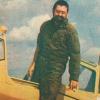-
Posts
2,224 -
Joined
-
Last visited
About KRK4m
- Birthday 25/04/1957
Profile Information
-
Gender
Male
-
Location
Krakow PL
-
Interests
1/72 a/c+AFV,1/144 airliners,1/700 ships,1/32 cars
Recent Profile Visitors
7,659 profile views
KRK4m's Achievements

Very Obsessed Member (5/9)
2.6k
Reputation
-
It's not a problem whether I like it or not. The model itself is great - interesting concept on the IS chassis, neatly done, convincing weathering, a.s.o. April Fools' Day comment was only about the fact that we are all now searching in sources whether a real ZSU-55-2 even existed , or is it your personal what-if. So my comment was not an attack on you. Cheers Michael
-
Is this a 3 month late April Fools joke? Cheers Michael
-
The production N-156 (because there were also prototypes of the F-5G/F-20) is in practice three different levels: T-38 with a dry wing, F-5A/B/C/D with a wet wing and a small LERX, and F-5E/F with a new, fatter and longer fuselage and radar in the nose. What's more - while the F-5B has a T-38 nose, thanks to which it does not differ in length from the F-5A, the F-5F has a normal long nose of a fighter (with radar), but due to the two-seater cabin it is much longer than the F-5E. The differences between the F-5A and F-5E are not as spectacular as between the F-84E and F-84F or the F-35A and F-35C, but incomparably greater than between the J79- and Spey-Phantoms. And overall the F-5A/B/C/D is more different from the F-5E/F than from the T-38. Cheers Michael
-
Yesterday I was looking at a 1963 LHD Daimler 2.5-litre (chassis 1A20010BW), registered as new in Switzerland. And it's the first time I've seen such a front lighting solution, and I've seen hundreds of such Daimlers and sister Jaguars. The car doesn't have side lights on the front wing tops (like the Mk1 or S-Type), but the indicator above the bumper is round (like the Mk2 and 240/340), only it's not amber but white and the bulb in it is a 21/5W dual-filament - it works as a side light and as an indicator. I once saw a 340 in Italy - it also had a round white indicator, but a single-filament 21W, because there was a white 5W side light on the wing top, and additionally a small amber indicator repeater on the side of the wing. So my question is: has anyone ever encountered such a solution and what was the reason for it? Let me remind you that this is the 10th LHD Daimler 2.5 (the first was 1A20001) and that both wings are original and do not show any signs of the torch's interference in order to remove the cigar-shaped embossments for the side lights. So did the first dozen or so Daimlers have Mk1 wings (Jaguar probably had a large stock of them), or was it a local Swiss requirement dictated by pedestrian safety (like the lack of the "flying D" emblem above the radiator grille)? Or maybe someone knows some other reason? I would love to know your opinion on this subject. Cheers Michael
-

A "4 1/2 litre" or "4.5 litre" badge from a British classic
KRK4m replied to KRK4m's topic in Vehicle Discussion
OK, @Noel Smith, that's a good lead. I just still don't know what to look for, in other words I don't know if any car ever had a badge like that. Daimler probably didn't, Lagonda definitely didn't, Bentley definitely didn't, and others? And that's the main reason for my post - not "will someone sell me such a badge" but "does anyone know that such a badge even existed". Cheers Michael -

A "4 1/2 litre" or "4.5 litre" badge from a British classic
KRK4m replied to KRK4m's topic in Vehicle Discussion
It's not the way, @veg The problem is that this badge is supposed to look like it was designed in the mid-20th century. For now, I'm looking for a ready-made one, but from what I can see, both the Bentley R-Type and the Daimler Majestic Major V8 did not have such badges on the rear of the car. But I only see photos, and you know these cars organoleptically - you grew up in their company. Hence my question. Because it's not a problem to find a modern "450" or even "4.5 liter" badge from a Mercedes or Cadillac - I want it to fit a body from 70 years ago. If I don't find a ready-made one, I'll design and print it in 3D. Cheers Michael -

A "4 1/2 litre" or "4.5 litre" badge from a British classic
KRK4m replied to KRK4m's topic in Vehicle Discussion
It's not that simple, @Neddy - it has to look like a badge from +/- 70 years ago. And no 4.6 there - it has to be "4 1/2 litre" or possibly "4.5 litre". That's why I'm bothering Britmodellers, because only you had such cars at that time... Cheers Michael -
I'm building a full-sized restomod with a British body and an equally British (I know it was born in Buick) Range Rover V8 4.6 engine. And I'd like to emphasize it with an equally British "4.5 litre" badge, or even better "4 1/2 litre". There aren't many cars like that - the Bentley R-Type and Mk.VI and the Daimler V8 Majestic Major come to mind. The question is, did any of them have such a badge on their body? A bare "4.5" from a Mercedes W108 280SE looks terribly Teutonic, and I don't really feel like modifying badges from a Rover P5B 3.5 litre or a Daimler V8 2.5 litre. Does anyone have a better idea? Cheers Michael
-

Query to folks with 1/144 airliners in the stash
KRK4m replied to Nocoolname's topic in Modern - 1969 and onwards
Actually I have two stashes - one in my flat and the other in the garage of my classic cars a few hundred metres from home. And I don't feel like going to the second one right now (check your watch ). And in my home stash I only have a dozen jetliners, half of which have fuselages without holes for windows, three have holes, but the manufacturer (Revell) doesn't provide windows, and only three (Zvezda) have windows. Of these three, the A320 has the largest windows (2.8x1.9mm), but these windows are not rectangles - rather something like a speedway track. The Tu-154 has rectangles, but tiny ones (2.3x1.7mm), and the B737 has rectangles that are a bit bigger (2.4x1.8mm). And since the transparent sprue is common to several B737 boxings, I have about 50+ unused windows left - if you give me your address in PM I can send them to you. Maybe one of our BM buddies also has a Zvezda B737 and can help you in your trouble, too. Cheers Michael -

Polska Howitzer Polowa 100 MM from FtF 1/72
KRK4m replied to Dieda's topic in Ready For Inspection - Dioramas
Dieda, please 🙏: either Polish Field Howitzer or Polska Haubica Polowa Mixing languages in technical vocabulary can lead to such tongue twisters as sottomarino nükleer – nosiciel bärare van mísseis termonucleares suborbitaux mit mehreren warheads Although a similar result can be obtained in a single language - for example Langstrecken-Allweterabfangjagdzweisitzer. But German is specific in this respect Cheers Michael -
Exactly 1,834cc (some 5%) larger, as it was just 4mm bored out with no change of stroke. Something like Opel Rekord CIH 1900 and 2000cc🚗 Cheers Michael
-
Believing in data from books published 40 or 50 years ago can end similarly to trusting weather forecasts - with going out into the snow in beach flip-flops. Cheers Michael
-
I can't tell you much about A/B/C/R, because the last time I had contact with them was a good 40 years ago. But when it comes to D/G, there are two good tools on the market - Fujimi and Academy. Basically, they only differ in that one is consistent with the drawings from those (roughly 50%) sources, according to which the Ju-87D is 11.50m long, and the other with the half, where it is 11.05m. And for 20 years, nobody has had the time to go to Hendon (where the only preserved specimen stands) and measure how much it really should be. Cheers Michael
-
It's great, @Geoffrey Sinclair, that you managed to get this data in numerical form, because on all the Warwick blueprints I know of, after converting the scale it came out to 14ft 8in for the R-2800-engined Mk.I & III and 14ft 3in for the Centaurus-engined Mk.II & V. Thus on the drawings also the British four-bladed ones are a few inches smaller than the American three-bladed ones. Great thanks again👏 Cheers Michael
-
The question may seem strange, but I have been intrigued by this topic for years. Especially since yesterday I came across this formulation in en.wikipedia.org: Initially, the Iowas carried the Vought OS2U Kingfisher and Curtiss SC Seahawk, both of which were employed to spot the battleship's main gun batteries – and, in a secondary capacity, perform search-and-rescue missions. Logically, it would seem that these were initially Kingfishers, and then (from spring 1945) Seahawks. But the "and" used in this sentence suggests that both types existed simultaneously, probably in a 2+1 arrangement (Iowas had 3 seaplanes as standard). I know Wiki is not a perfect source, but logic is not always followed, too. An additional aspect is Yamato (a potential equivalent of Iowa), which certainly had E13As and F1Ms on board at the same time. So does anyone have any data (preferably a photo) indicating the simultaneous presence of OS2U and SC-1 on Iowa board, or was it just that one day in 1945 when Kingfishers were lifted by crane to the shore and Seahawks were transferred on board? Cheers Michael









